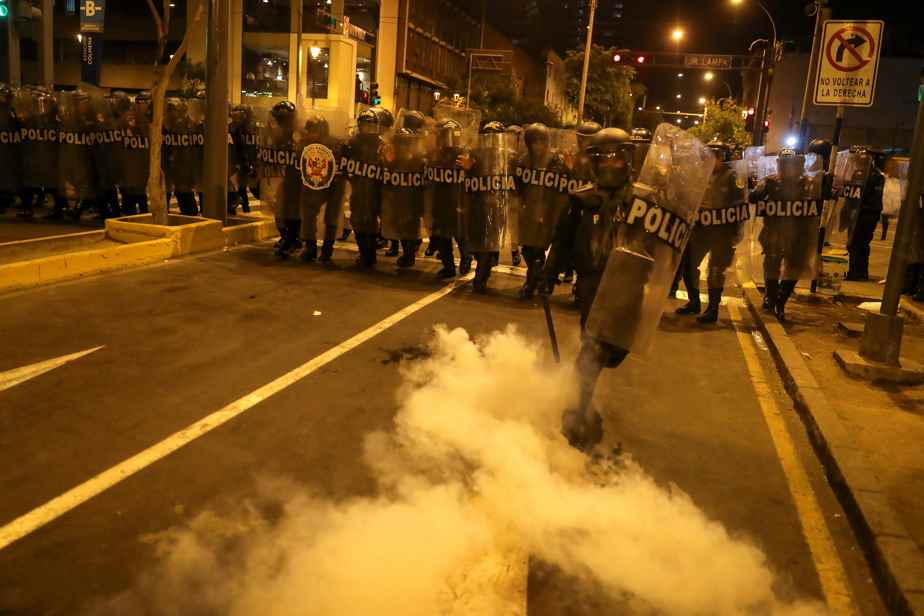(Lima) The Peruvian government has ordered the intervention of the police and the army to clear, in the coming hours, the dozens of roadblocks set up across the country by demonstrators demanding the resignation of President Dina Boluarte.
“The National Police of Peru, with the support of the Armed Forces, will carry out the unblocking of the roads of the national network”, announced Thursday evening the Ministries of Interior and Defense in a press release.
Authorities on Thursday identified 88 barricades on roads in 8 of Peru’s 25 regions. These roadblocks lead to shortages of basic products and fuel, drive up prices and, according to the government, complicate access to care and the arrival of medicines in several areas of the country.
The central highway that connects the Andes and is the main route for importing food products to Lima has notably been closed. Hundreds of trucks are blocked.
The government has accused the dams of being the direct cause of ten deaths, including those of three children who, according to it, were unable to receive the critical care they needed in time.
“On this date, ten innocent Peruvians have lost their lives because of this illegal act”, denounced the two ministries in their press release.
“Right to life”
The right to protest ‘does not include blocking the way, much less can trump the right to life of people who need to be transported to receive treatment […] or who need oxygen or medicine to come to their areas so they can continue to live,” they added.

PHOTO LUCAS AGUAYO, AGENCY FRANCE-PRESSE
An opponent of President Dina Boluarte is arrested during a demonstration in Lima.
Peru has been in the grip of a serious political crisis since the dismissal and arrest on December 7 of socialist President Pedro Castillo, accused of an attempted coup for having wanted to dissolve the parliament which was preparing to oust him from power.
The clashes between security forces and pro-Castillo demonstrators, who demand the resignation of Mme Boluarte and immediate elections, left at least 46 dead in six weeks.
Dina Boluarte, former vice-president and running mate of Mr. Castillo in the 2021 elections and of the same modest and Andean origins as him, replaced him in accordance with the Constitution. But she is considered “a traitor” by the demonstrators.
“Against Dictatorship”
Above all, this crisis reflects the huge gap between the capital and the poor provinces, notably the southern Andean region, which supported Mr. Castillo and saw his election as revenge for what they consider to be Lima’s contempt.
Thursday in the capital, several hundred people again gathered calmly in Dos de Mayo square. “We are fighting against the dictatorship of Dina Boluarte,” protester Eduardo Vazquez told AFP as he handed out rations of cau cau, a typical dish made from beef tripe, to other protesters.

PHOTO MARTIN MEJIA, ASSOCIATED PRESS
Riot police try to disperse protesters in Lima.
However, clashes between demonstrators and police broke out in the historic center of the capital. Some threw stones and firecrackers, and others responded with rubber bullets and tear gas.
In Juliaca, a mining town in the Puno region (south), relatives of victims of the demonstrations demanded “justice” on Thursday from the government of Dina Boluarte.
“I only ask for justice. I ask you to help us because no one will give my brother back to me”, exclaimed, in tears, María Samillán, sister of the doctor Marco Antonio Samillán, 31, shot dead during a demonstration in Juliaca.
In this poor region of the southern Andes, a clash with the police during an attempt to take control of the airport on January 9 left 18 dead, including a police officer who was burned alive.
“Every day I feel like I’m dying too. I can’t live anymore,” said M.me Samillán during a press conference with the National Committee for the Coordination of Human Rights (CNDDHH).
The cities of Juliaca and Puno, more than 1350 km south of the capital Lima, were the scene of the most violent demonstrations.
